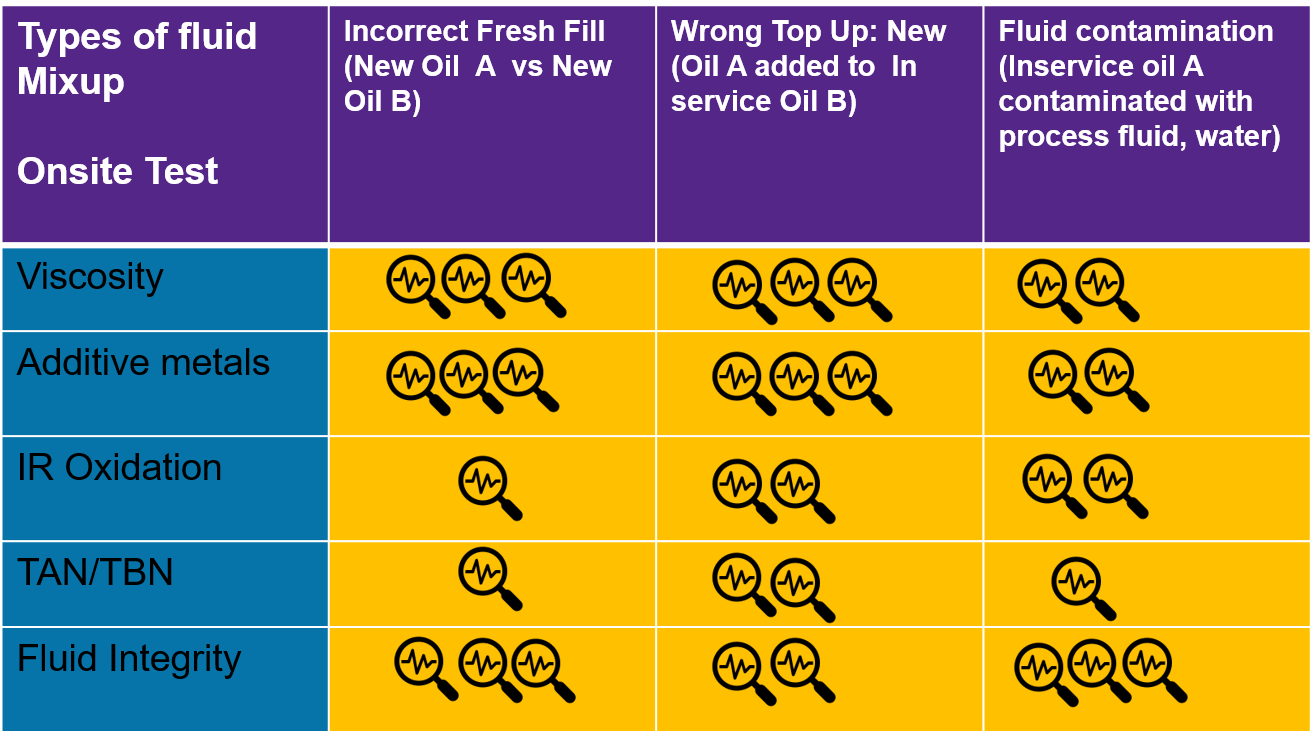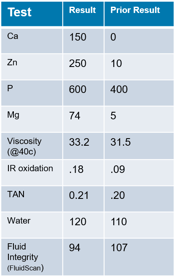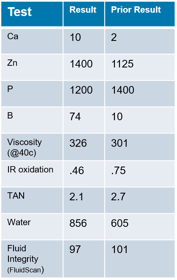What is lubricant mix-up?
Lubricant mix-up describes any situation where the lubricant, new or in service, does not meet the exact specification requirement.
Why is it an issue?
If the correct oil is not present in the system, or there is a bit of a mix, there could be some premature wear. Corrosion and insufficient performance also could be a possibility. There are other situations where the lubricants are not compatible or there is a miscibility problem which leads to pumping and starvation issues.
How do we detect fluid mix-up?
There is no all-in-one test available; however, a routine combination of on-site tests can provide some information and clues to what is actually happening. Major tests of interest would be tests such as looking at additives (elemental spectroscopy) viscosity, infrared fluid integrity, particle count, total acid number (TAN), and total base number (TBN). Looking at all of the results together from various tests can indicate when a lubricant mix up has occurred. The tests alone are not definitive, so here are some examples of a combination of tests can help determine if the fluids are mixed.
Situations

There are different scenarios for lubricant fluid mix up presented by the table above. One condition is where a brand-new Oil A has been added to equipment, however Brand B is the correct fill. Assuming that both oils A and B have the same viscosity, but the additives are different. Measuring for additive elements will be very helpful. The other tests will provide some information. A second situation can be if Oil A and Oil B do not share the same viscosity grade. In that case, the viscosity measurement may be the first clue that something is wrong.
A very common situation is when there is a new Oil A being added to (topped off) an in service Oil B. Here the additive packages are quite different, but the small addition may not be immediately noticeable in the elemental analysis results. One thing we want to bring attention to is a new feature that we have on the MiniLab systems with FluidScan. The FluidScan now offers a fluid integrity reading which allows the user to see a change that occurs, possibly due to fluid mix-up or normal contamination that may be present in the system, and is very helpful when the small change in viscosity or additive elements is not conclusive.
You will notice on the table that common tests on the suite are not definitive, and varies with the mix-up condition of interest. The best way to detect lubricant mix-up is to have a routine condition monitoring program where testing can occur on-site with the equipment and the oil can be tested on a regular basis. This way a change from the original values can be detected very quickly.
Examples
 Let's look at a few examples of real world fluid mix-ups and how the MiniLab suite helped to detect them. The first case here is a turbine oil reservoir in a power plant. Looking at the current result and then comparing the prior result is effective for detection (the power of trend monitoring) and we notice a couple of observations. There is a big change in the additive elements. The viscosity hasn't changed that much, but there is a little bit of an increase in acid number. There is a slight increase in water content and the fluid integrity has changed a little bit as well. The additive elements are so dramatically different and the nature of those are such that it looks like they're coming from engine oil. It looks like engine oil was added into this fluid, so it's clear that there is a fluid mix-up due to an addition (topping off) of engine oil. All tests are indicating that, but the most convincing evidence is from the elemental additives. The fluid integrity value also reinforces this, especially when water and oxidation values are low.
Let's look at a few examples of real world fluid mix-ups and how the MiniLab suite helped to detect them. The first case here is a turbine oil reservoir in a power plant. Looking at the current result and then comparing the prior result is effective for detection (the power of trend monitoring) and we notice a couple of observations. There is a big change in the additive elements. The viscosity hasn't changed that much, but there is a little bit of an increase in acid number. There is a slight increase in water content and the fluid integrity has changed a little bit as well. The additive elements are so dramatically different and the nature of those are such that it looks like they're coming from engine oil. It looks like engine oil was added into this fluid, so it's clear that there is a fluid mix-up due to an addition (topping off) of engine oil. All tests are indicating that, but the most convincing evidence is from the elemental additives. The fluid integrity value also reinforces this, especially when water and oxidation values are low.
 Let's look at a common industrial lubrication issue. In this example, a specified synthetic product is supposed to go into a gearbox application, but instead there is something similar to a mineral oil with the same viscosity but with different additive packages. The viscosities and additive levels are very similar, and not outside the common variability when new oil is added to in-service oil. The oxidation and acid numbers are quite low, but notice the fluid integrity has seen a change. It may not be a performance-based issue right now, but there are certainly some differences that need to be noted. As mentioned previously, the user can see the differences depending on the tests. The user is able to flag those by using their alarm-based system in our TruVu 360 application, which also allows alarms to be modified to tighten those specifications.
Let's look at a common industrial lubrication issue. In this example, a specified synthetic product is supposed to go into a gearbox application, but instead there is something similar to a mineral oil with the same viscosity but with different additive packages. The viscosities and additive levels are very similar, and not outside the common variability when new oil is added to in-service oil. The oxidation and acid numbers are quite low, but notice the fluid integrity has seen a change. It may not be a performance-based issue right now, but there are certainly some differences that need to be noted. As mentioned previously, the user can see the differences depending on the tests. The user is able to flag those by using their alarm-based system in our TruVu 360 application, which also allows alarms to be modified to tighten those specifications.
Solutions
When there's a change the question is, "What do you do when a change has been identified? What are your options as an equipment maintainer?" There are three major actions to take. The first is to change the oil. This is recommended for small gearbox applications and in certain industries such as nuclear, food, aviation; it's better to simply change the oil out immediately to avoid any risks. In other applications such as power plants where there are very large reservoirs, or in refineries, a possible solution is to do a feed and bleed. This approach is common when a fluid mix-up may not be affecting performance and it is possible to work it out by doing a change and add as it goes along. The third solution is to do take no maintenance action immediately, but monitor closely and watch to see if there are any change in conditions or any abnormalities. This is referred to as "nursing" the equipment. Sample much more frequently and use an on-site solution to be able to detect changes rapidly. In all cases, you have a solution for lubricant mix-up and you can eliminate that problem from becoming an issue in your facilities.



